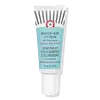What's inside
What's inside
 Key Ingredients
Key Ingredients

 Benefits
Benefits

 Concerns
Concerns

 Ingredients Side-by-side
Ingredients Side-by-side

Water
Skin ConditioningCaprylic/Capric Triglyceride
MaskingGlycerin
HumectantCetearyl Alcohol
EmollientGlyceryl Stearates
EmollientCetearyl Olivate
Leuconostoc/Radish Root Ferment Filtrate
AntimicrobialSorbitan Olivate
EmulsifyingPotassium Cetyl Phosphate
EmulsifyingSclerocarya Birrea Seed Oil
HumectantTetradecane
PerfumingButyrospermum Parkii Butter
Skin ConditioningAlbizia Julibrissin Bark Extract
MaskingDarutoside
Skin ConditioningHibiscus Sabdariffa Flower Extract
Skin ConditioningAvena Sativa Kernel Extract
AbrasiveXanthan Gum
EmulsifyingPotassium Sorbate
PreservativeSodium Dehydroacetate
PreservativeWater, Caprylic/Capric Triglyceride, Glycerin, Cetearyl Alcohol, Glyceryl Stearates, Cetearyl Olivate, Leuconostoc/Radish Root Ferment Filtrate, Sorbitan Olivate, Potassium Cetyl Phosphate, Sclerocarya Birrea Seed Oil, Tetradecane, Butyrospermum Parkii Butter, Albizia Julibrissin Bark Extract, Darutoside, Hibiscus Sabdariffa Flower Extract, Avena Sativa Kernel Extract, Xanthan Gum, Potassium Sorbate, Sodium Dehydroacetate
Water
Skin ConditioningDimethicone
EmollientGlycerin
HumectantMaris Aqua
HumectantButylene Glycol
HumectantNiacinamide
SmoothingPolysilicone-11
Caprylic/Capric Triglyceride
MaskingMica
Cosmetic ColorantPanthenol
Skin ConditioningSodium Stearoyl Glutamate
CleansingCaffeine
Skin ConditioningCamellia Sinensis Leaf Extract
AntimicrobialCaprylyl Glycol
EmollientChrysanthemum Parthenium Extract
Skin ConditioningCitric Acid
BufferingCoffea Arabica Seed Extract
MaskingCorallina Officinalis Extract
Skin ConditioningCucurbita Pepo Seed Extract
Skin ConditioningGigartina Stellata/Kappaphycus Alvarezii Extract
Skin ProtectingGlyceryl Polyacrylate
Glycyrrhiza Glabra Root Extract
BleachingHexylene Glycol
EmulsifyingHydrogenated Polydecene
EmollientHydrogenated Polydicyclopentadiene
Hydroxyacetophenone
AntioxidantHydroxyethyl Acrylate/Sodium Acryloyldimethyl Taurate Copolymer
Emulsion StabilisingLaureth-8
EmulsifyingLecithin
EmollientLinoleic Acid
CleansingOleic Acid
EmollientPalmitic Acid
EmollientPhytosteryl Canola Glycerides
Skin ConditioningPhytosteryl/Octyldodecyl Lauroyl Glutamate
Skin ConditioningPolysorbate 60
EmulsifyingSilica
AbrasiveSodium Acrylate/Sodium Acryloyldimethyl Taurate Copolymer
Emulsion StabilisingSodium Ascorbyl Phosphate
AntioxidantSodium Hyaluronate
HumectantSorbitan Isostearate
EmulsifyingSqualane
EmollientStearic Acid
CleansingTocopherol
AntioxidantTriolein
Skin ConditioningXanthan Gum
EmulsifyingPhenoxyethanol
PreservativePotassium Sorbate
PreservativeSodium Benzoate
MaskingCI 77491
Cosmetic ColorantCI 77891
Cosmetic ColorantWater, Dimethicone, Glycerin, Maris Aqua, Butylene Glycol, Niacinamide, Polysilicone-11, Caprylic/Capric Triglyceride, Mica, Panthenol, Sodium Stearoyl Glutamate, Caffeine, Camellia Sinensis Leaf Extract, Caprylyl Glycol, Chrysanthemum Parthenium Extract, Citric Acid, Coffea Arabica Seed Extract, Corallina Officinalis Extract, Cucurbita Pepo Seed Extract, Gigartina Stellata/Kappaphycus Alvarezii Extract, Glyceryl Polyacrylate, Glycyrrhiza Glabra Root Extract, Hexylene Glycol, Hydrogenated Polydecene, Hydrogenated Polydicyclopentadiene, Hydroxyacetophenone, Hydroxyethyl Acrylate/Sodium Acryloyldimethyl Taurate Copolymer, Laureth-8, Lecithin, Linoleic Acid, Oleic Acid, Palmitic Acid, Phytosteryl Canola Glycerides, Phytosteryl/Octyldodecyl Lauroyl Glutamate, Polysorbate 60, Silica, Sodium Acrylate/Sodium Acryloyldimethyl Taurate Copolymer, Sodium Ascorbyl Phosphate, Sodium Hyaluronate, Sorbitan Isostearate, Squalane, Stearic Acid, Tocopherol, Triolein, Xanthan Gum, Phenoxyethanol, Potassium Sorbate, Sodium Benzoate, CI 77491, CI 77891
 Reviews
Reviews

Ingredients Explained
These ingredients are found in both products.
Ingredients higher up in an ingredient list are typically present in a larger amount.
This ingredient is an emollient, solvent, and texture enhancer. It is considered a skin-softener by helping the skin prevent moisture loss.
It helps thicken a product's formula and makes it easier to spread by dissolving clumping compounds.
Caprylic Triglyceride is made by combining glycerin with coconut oil, forming a clear liquid.
While there is an assumption Caprylic Triglyceride can clog pores due to it being derived from coconut oil, there is no research supporting this.
Learn more about Caprylic/Capric TriglycerideGlycerin is already naturally found in your skin. It helps moisturize and protect your skin.
A study from 2016 found glycerin to be more effective as a humectant than AHAs and hyaluronic acid.
As a humectant, it helps the skin stay hydrated by pulling moisture to your skin. The low molecular weight of glycerin allows it to pull moisture into the deeper layers of your skin.
Hydrated skin improves your skin barrier; Your skin barrier helps protect against irritants and bacteria.
Glycerin has also been found to have antimicrobial and antiviral properties. Due to these properties, glycerin is often used in wound and burn treatments.
In cosmetics, glycerin is usually derived from plants such as soybean or palm. However, it can also be sourced from animals, such as tallow or animal fat.
This ingredient is organic, colorless, odorless, and non-toxic.
Glycerin is the name for this ingredient in American English. British English uses Glycerol/Glycerine.
Learn more about GlycerinPotassium Sorbate is a preservative used to prevent yeast and mold in products. It is commonly found in both cosmetic and food products.
This ingredient comes from potassium salt derived from sorbic acid. Sorbic acid is a natural antibiotic and effective against fungus.
Both potassium sorbate and sorbic acid can be found in baked goods, cheeses, dried meats, dried fruit, ice cream, pickles, wine, yogurt, and more.
You'll often find this ingredient used with other preservatives.
Learn more about Potassium SorbateWater. It's the most common cosmetic ingredient of all. You'll usually see it at the top of ingredient lists, meaning that it makes up the largest part of the product.
So why is it so popular? Water most often acts as a solvent - this means that it helps dissolve other ingredients into the formulation.
You'll also recognize water as that liquid we all need to stay alive. If you see this, drink a glass of water. Stay hydrated!
Learn more about WaterXanthan gum is used as a stabilizer and thickener within cosmetic products. It helps give products a sticky, thick feeling - preventing them from being too runny.
On the technical side of things, xanthan gum is a polysaccharide - a combination consisting of multiple sugar molecules bonded together.
Xanthan gum is a pretty common and great ingredient. It is a natural, non-toxic, non-irritating ingredient that is also commonly used in food products.
Learn more about Xanthan Gum